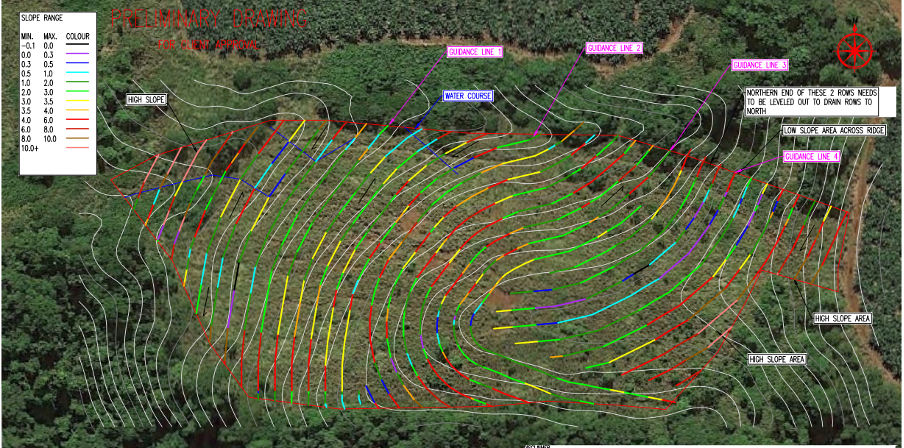New soils form at a rate of about 1cm per century so there is no level of ‘tolerable soil loss’ given the time it takes to replace.
Pictured: A new block layout prepared for a banana grower in Innisfail area.
A wise banana grower once said that he didn’t purchase 100 acres of land but 20cm of premium topsoil. Keeping that soil on the paddocks is a benefit to both the farm productivity and the surrounding waterways.
The productive topsoil layer in the Wet Tropics, where most bananas are grown, can be shallow due to the high rainfall and rapid rates of decomposition.
Amelia Foster, the ABGC’s Best Practice Coordinator, recently worked with Soil Conservationist Darryl Evans to design a new block on an existing banana farm.
“The block had a variety of gradients and a contour layout will ensure that the risk of soil loss is reduced in the long term,” Ms Foster said. The design has been digitized by Tahlee Engineering and can now be laid out by the earthworking contractor using the GPS on this tractor.
Modern farm planning considers the location of the farm within the landscape, the soil types, the natural flow of water through and from the farm and the lay of the land itself. There are a range of measures that growers can implement including diversion banks, grassed waterways, contoured paddocks on sloped land and sediment traps.
Floods in the Wet Tropics regularly deliver large levels of eroded soil from the river catchments to the Great Barrier Reef. Sediment is harmful to the Great Barrier Reef as it can smother coral polyps, block the sunlight necessary for photosynthesis, and disrupt the delicate balance of the reef ecosystem by reducing water clarity and promoting algae growth.
Proper farm and paddock planning can help to minimise the loss of soil, even in our high rainfall areas across the Tully and Johnstone catchments. Regulations introduced in 2020 introduced minimum practice agricultural standards for bananas that aim to minimise sediment loss by having appropriate erosion and sediment control measures in places where is a high risk of soil loss from the farm.
The ABGC BMP Team works with growers to plan farm and paddock layouts in both new farms and as growers are replanting blocks. ABGC also offers free Sediment Management Workshops where growers can work with other growers to better understand the topography and soils on their own farm.
If banana growers are interested in farm planning, they can email bmp@abgc.org.au
The Banana Best Management Practice Project (2023-2026) is funded through the Queensland Government’s Queensland Reef Water Quality Program and delivered by Australian Banana Growers’ Council’s in partnership with growers.

